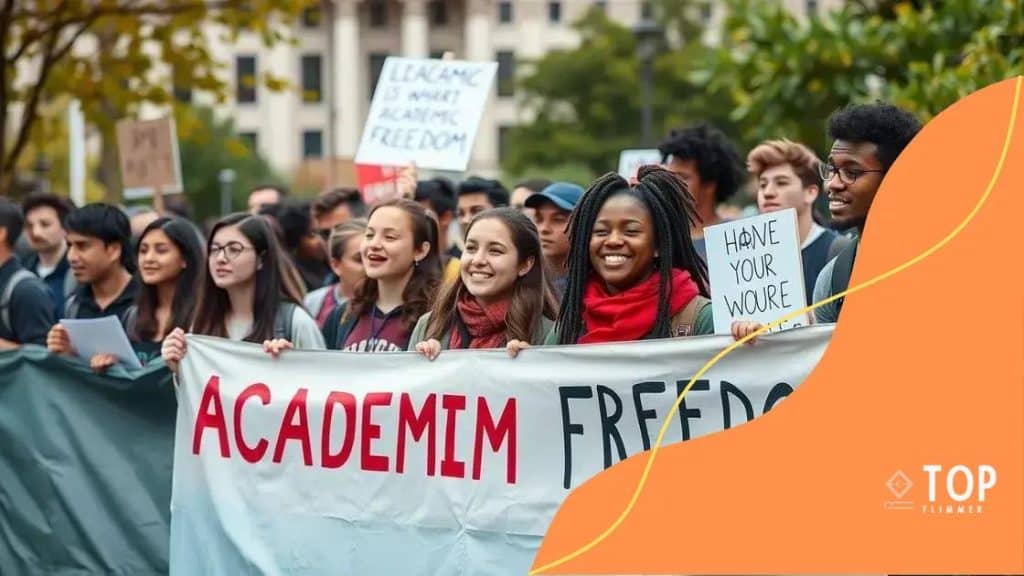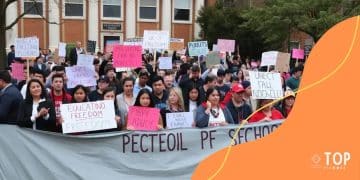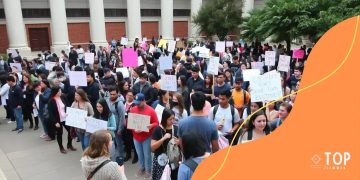Student protests for academic freedom: What you need to know

Student protests for academic freedom are crucial movements that advocate for the rights of students and educators to express ideas freely within educational institutions, prompting significant changes in policies and practices.
Student protests for academic freedom have surged in recent years, igniting conversations about rights and responsibilities in academia. Why are students taking a stand, and what does it mean for the future of education? Let’s dive into this pressing issue.
The history of student protests for academic freedom
The history of student protests for academic freedom is rich and varied. It showcases how students have fought for their rights and beliefs throughout the decades. Understanding this history helps us see why such movements are essential in today’s educational landscape.
Students have often taken the lead in advocating for their rights. One notable instance was during the Vietnam War when many campuses erupted with protests against military involvement. Students argued that their academic institutions should be safe spaces for free thought and expression, free from government influence.
The 1960s: A Turning Point
The 1960s marked a significant turning point for student activism. Universities became hotbeds of political and social change. Students organized rallies, sit-ins, and demonstrations. Their goal was clear: to demand more academic freedom and challenge oppressive policies.
- The Free Speech Movement at UC Berkeley sparked national attention.
- Students rallied against censorship and military recruitment on campus.
- Grassroots organizations fought for greater rights for marginalized voices.
As we moved into the 1980s and beyond, student protests continued to evolve. With the rise of technology, communication became more accessible. Students could organize and mobilize quickly. Social media became a critical tool for promoting academic freedom and connecting like-minded individuals.
Recent Developments
In recent years, we’ve seen protests that center around issues such as racial inequality, climate change, and mental health resources on campuses. These movements often highlight the need for universities to not only provide education but also to be environments of support and open dialogue.
- Protests have focused on tuition fees and accessibility in higher education.
- Students advocate for transparent administrative policies concerning free speech.
- Resistance against oppressive practices within academic institutions has intensified.
Throughout history, student protests for academic freedom have shaped policies and opened discussions that are crucial for the education system. As these movements continue to thrive, they remind us that the fight for freedom and equity is an ongoing journey, vital for future generations.
Key moments in recent student protest movements
Recent student protest movements have marked significant changes in how young people engage with social issues. The key moments in recent student protest movements tell a compelling story of activism and leadership among students.
One important event occurred in 2018 when students across the United States mobilized after the tragic shooting at Marjory Stoneman Douglas High School. These students organized the March for Our Lives, calling for stricter gun control laws. Their passion and determination inspired a nationwide conversation about gun safety, illustrating the power of student activism.
Climate Change Activism
Another pivotal moment happened with the rise of climate change activism. Inspired by young activist Greta Thunberg, students globally have participated in school strike movements, pushing for urgent action against climate change. They have used social media to spread awareness and connect with others who share their concerns.
- School strikes began in August 2018, with students skipping class to demand climate action.
- Climate strikes have garnered millions of participants worldwide, uniting youth voices.
- These protests have influenced policies and engaged leaders to address climate change.
Additionally, movements addressing racial inequality have gained momentum. In 2020, following the death of George Floyd, students from various backgrounds took to the streets demanding justice and reform. They highlighted the need for equity in education and broader societal change, emphasizing the role of academic freedom in fostering a just environment.
College Tuition and Debt Protests
Economic issues have also sparked protests among students. Rising tuition costs and student loan debt have led many to organize rallies advocating for affordable education. These events have urged colleges and governments to reconsider funding models.
- Students have protested against tuition hikes, calling for free college education.
- They have pushed for loan forgiveness policies to alleviate financial burdens.
- Protesters demand transparency in how tuition fees are used.
By participating in these protests, students not only raise their voices but also promote change in policies that directly affect their futures. The energy and commitment displayed during these key moments highlight a growing awareness among young people and their role in shaping the world.
How academic freedom is defined and challenged

Academic freedom is a fundamental principle that allows scholars and students to explore, teach, and discuss ideas without fear of censorship or retaliation. It serves as the backbone of educational institutions, fostering a culture of open inquiry. However, the definition and implementation of academic freedom can vary widely among different settings.
In its essence, academic freedom protects the rights of educators to teach subjects according to their expertise and for students to engage with challenging ideas. This freedom is essential for creating a vibrant academic environment where diverse perspectives can be shared. However, it is often met with challenges that threaten its existence.
Challenges to Academic Freedom
One significant challenge arises from political pressure. In recent years, various governments have attempted to influence academic curricula. These pressures can lead to self-censorship among faculty who fear negative consequences for discussing contentious topics.
- Censorship from administration can stifle discussions on sensitive subjects.
- Political affiliations may affect funding for research, impacting academic programs.
- Public backlash against certain viewpoints can discourage open dialogue.
Moreover, social media plays a dual role in shaping academic freedom. While it allows for the rapid spread of ideas, it can also lead to harassment and threats against professors and students who express unpopular opinions. The fear of backlash can create an atmosphere where individuals hesitate to voice their thoughts.
The Role of Institutions
Universities and colleges are tasked with defending academic freedom. They should create policies that protect the rights of faculty and students. For example, clear guidelines on protecting individuals from harassment can help promote free expression in academic settings.
- Institutions can implement training programs on academic freedom.
- Support systems and resources for those facing threats are essential.
- Fostering a culture of respect for diverse opinions strengthens academic discourse.
As the landscape of education evolves, it is crucial to understand both the importance of academic freedom and the challenges it faces. Advocating for and protecting this freedom is vital to ensuring that universities remain places of innovation and critical thought.
The impact of protests on university policies
The impact of protests on university policies is significant, as student movements can drive changes that resonate far beyond the campus. When students unite and voice their concerns, it creates a powerful force that institutions cannot ignore.
Historically, many protests have led to reforms in policies affecting various aspects of university life. For instance, movements advocating for diversity and inclusion have pushed universities to re-evaluate admissions policies, ensuring fair representation of marginalized groups.
Changes in Admissions and Curriculum
As students call for changes, universities often respond by adjusting their admissions criteria and academic programs. This evolution helps create a more inclusive environment. Students’ activism has urged universities to implement courses that cover social justice, environmental issues, and other critical matters.
- Greater emphasis on diversity in student admissions.
- Incorporation of social justice topics in curricula.
- Training for faculty on inclusivity in the classroom.
Furthermore, increased demands for transparency in university governance have led to more student representation in decision-making processes. Students are no longer passive recipients of educational policies; they now play an active role in shaping their institutions.
Policy Revisions and Funding
Protests have also triggered significant policy revisions. For example, when students rally against tuition hikes or inadequate mental health resources, universities often find themselves under pressure to review their funding strategies. This activism can result in substantial changes that enhance student welfare.
- Review of tuition and fee structures to ensure affordability.
- Increased funding for mental health services and support.
- Establishment of better communication channels between students and administration.
As institutions respond to student protests, they may develop new policies that reflect student voices. This evolving dialogue can lead universities to create more robust programs addressing student needs, encouraging a culture of collaboration and respect.
Voices from the front lines of academic freedom
Voices from the front lines of academic freedom provide essential insights into the struggles and triumphs faced by students and educators in their quest for an open and equitable academic environment. These voices are crucial in understanding how academic freedom impacts teaching, learning, and the overall educational experience.
Many students and faculty have shared their experiences of navigating challenges related to censorship and restrictions on their right to speak freely. For instance, a professor at a large university may recall how their research on controversial topics faced scrutiny, leading to self-censorship. This reality can stifle creativity and academic exploration, ultimately harming the educational community.
Student Experiences
Students are often at the forefront of advocating for their rights and freedoms. Numerous accounts highlight how students have organized protests to voice their dissatisfaction with administrative policies that limit their expression. These actions signal a strong desire to engage in discussions on social justice, climate change, and other pressing issues.
- Students have faced backlash for speaking out on sensitive issues.
- Many have collaborated in groups to ensure their voices are heard.
- Acts of solidarity have helped to amplify individual stories.
Additionally, student organizations play a vital role in promoting academic freedom by rallying support for free speech on campus. They challenge university administrations to create environments where diverse ideas can flourish without fear of retaliation.
Faculty Perspectives
Faculty members have also expressed concerns about protecting their academic freedom. Many have dedicated their careers to researching and teaching complex subjects that may provoke controversy. The fear of losing funding or facing disciplinary actions can discourage educators from pursuing essential topics.
- Professors advocate for clearer guidelines on academic freedom.
- They push for institutional support when facing challenges.
- Many share their experiences to educate others about the importance of academic freedom.
By sharing their stories, both students and faculty highlight the ongoing fight for academic freedom. Their voices illustrate the need for continual advocacy and awareness within academic communities, emphasizing that these struggles shape the educational landscape and its future.
FAQ – Questions About Academic Freedom and Student Protests
What is academic freedom?
Academic freedom is the principle that allows scholars and students to pursue knowledge and express ideas freely without censorship or retribution.
How do student protests impact university policies?
Student protests can lead to significant changes in university policies concerning admissions, curriculum, and support resources, pushing for a more inclusive academic environment.
What challenges do students face in advocating for academic freedom?
Students often encounter backlash, censorship, and political pressure that can hinder their ability to speak out and engage in discussions.
Why is it important to support academic freedom?
Supporting academic freedom is essential for fostering a vibrant learning community where diverse ideas can be shared, ultimately leading to innovation and social progress.






